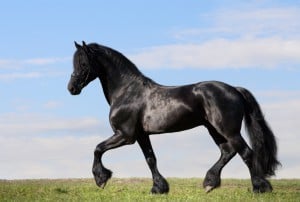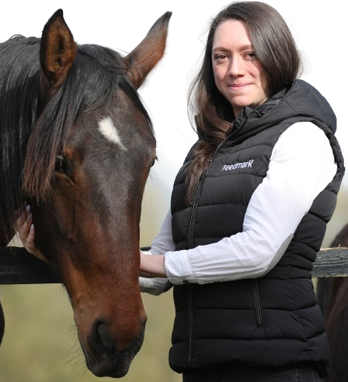As we leave winter behind and the promise of sunny days is beckoning, you may well notice that your horse is starting to shed their thick coat, revealing a sleek and smart summer outfit. This shedding is mainly caused by longer hours of daylight. The increase and decrease in daylight hours triggers the production of hormones responsible for hair growth and shedding. This change of coats over the course of the year is mainly to help the horse with thermoregulation: during the winter a longer and thicker coat is required, and when cold weather hits these hairs are erected, so trapping a layer of warm air next to the skin. In the summer, a finer coat is needed so the coat can lie flat, allowing air flow across the skin, and a shiny, smooth coat will also reflect some heat from the sun. In order for skin and coat to stay healthy and for effective shedding to take place, the horse must receive a balanced diet, with the correct levels of dietary fat (especially omega-3, which must be supplied in the diet and is essential for skin condition), protein, and vitamins and minerals, notably vitamin A, zinc, iodine, copper, biotin, and other b-vitamins. Too much seleniu m, iodine or vitamin A is also detrimental, so don’t over feed these nutrients. Providing you are feeding either recommended amounts of a complete food or balancer, or toping up a fibre-based diet using a vitamin and mineral supplement, your horses should be receiving the necessary vitamins and minerals for healthy skin and coat. To complement an already balanced diet, we suggest adding vital omega oils, additional B-vitamins and useful herbs into the diet. Chamomile is well known as a skin soother and helps to reduce irritation, while Burdock root helps to keep skin scurf-free. Clivers are also included for their high levels of silica, which strengthens skin and hair, and nettles promote coat dappling, and also have tonic properties, cleansing the blood. By helping to keep your horse’s coat shiny and scurf free, and the skin healthy you can reduce the risk of problems such as sweet itch and mud fever, and keep your horse looking great- ideal for the show or sales ring! Help your horse shed! Groom regularly to help remove excess hair, and if desired use specialised shedding tools Anecdotally those who are exercised regularly lose their hair more quickly, possibly to do with increased blood flow to the skin stimulating hair follicles Feed supplements aimed at boosting skin and coat health to make sure that the skin and coat are in prime condition for shedding Ensure your worming programme is up to date, as parasite burdens can affect coat quality Wearing overalls can help you stay less hairy when grooming shedding horses- the hair will get everywhere, and fleece and wool jumpers can be particularly hard to remove hairs from! FOLLOWING THE TIPS ABOVE AND YOUR HORSE IS STILL NOT SHEDDING? If your horse is not shedding as normal, or the summer coat does not look as expected, especially if they are an older horse, take note: Delayed shedding, or growth of a long, wavy, thick coat is one sign that your horse may be developing Cushing’s disease. This coat growth is known as ‘hirsutism’ – and occurs due to enlargement of the pars intermedia in the pituitary gland, which in turn compresses the hypothalamus, the section of the brain which regulates body temperature, appetite and seasonal shedding. If you think your horse may have Cushing’s, consult with your vet, and for help regarding dietary changes that may be necessary please call one of our Nutritional advisors on 0800 585525. Olivia Colton MSc Nutritional and Technical Coordinator
m, iodine or vitamin A is also detrimental, so don’t over feed these nutrients. Providing you are feeding either recommended amounts of a complete food or balancer, or toping up a fibre-based diet using a vitamin and mineral supplement, your horses should be receiving the necessary vitamins and minerals for healthy skin and coat. To complement an already balanced diet, we suggest adding vital omega oils, additional B-vitamins and useful herbs into the diet. Chamomile is well known as a skin soother and helps to reduce irritation, while Burdock root helps to keep skin scurf-free. Clivers are also included for their high levels of silica, which strengthens skin and hair, and nettles promote coat dappling, and also have tonic properties, cleansing the blood. By helping to keep your horse’s coat shiny and scurf free, and the skin healthy you can reduce the risk of problems such as sweet itch and mud fever, and keep your horse looking great- ideal for the show or sales ring! Help your horse shed! Groom regularly to help remove excess hair, and if desired use specialised shedding tools Anecdotally those who are exercised regularly lose their hair more quickly, possibly to do with increased blood flow to the skin stimulating hair follicles Feed supplements aimed at boosting skin and coat health to make sure that the skin and coat are in prime condition for shedding Ensure your worming programme is up to date, as parasite burdens can affect coat quality Wearing overalls can help you stay less hairy when grooming shedding horses- the hair will get everywhere, and fleece and wool jumpers can be particularly hard to remove hairs from! FOLLOWING THE TIPS ABOVE AND YOUR HORSE IS STILL NOT SHEDDING? If your horse is not shedding as normal, or the summer coat does not look as expected, especially if they are an older horse, take note: Delayed shedding, or growth of a long, wavy, thick coat is one sign that your horse may be developing Cushing’s disease. This coat growth is known as ‘hirsutism’ – and occurs due to enlargement of the pars intermedia in the pituitary gland, which in turn compresses the hypothalamus, the section of the brain which regulates body temperature, appetite and seasonal shedding. If you think your horse may have Cushing’s, consult with your vet, and for help regarding dietary changes that may be necessary please call one of our Nutritional advisors on 0800 585525. Olivia Colton MSc Nutritional and Technical Coordinator
Spring coat changes
16 Feb 2016
